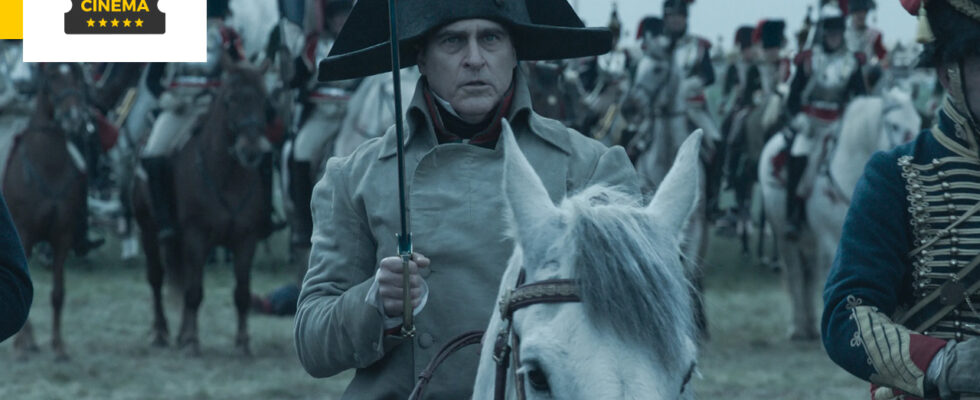Ridley Scott could not ignore the Battle of Waterloo, Napoleon’s final confrontation which would seal the fate of his empire once and for all. But how did the filmmaker go about recreating it?
Twenty-three years after having played under the auspices of Ridley Scott the tyrant Commodus in his Gladiator, Joaquin Phoenix this time dons the bicorne of an illustrious figure of our History, Napoleon.
French historians and critics may criticize his film and belch at the (great) liberties taken by the filmmaker on the character and events he chose to show, but Scott brushes them aside. .
“It’s difficult to make a film like this, because it’s a historical film, and you shouldn’t make it a history lesson,” Scott comments.
4h30 of Napoleon: Ridley Scott wants to release a long version with Joaquin Phoenix!
If Napoleon led dozens of famous battles, such as those of Jena, Wagram, Friedland or Moskowa (otherwise called Borodino), it was logically impossible for the director to show too much in a 2h40 feature film, forcing him to make drastic choices.
And they are rather intelligent in this aspect, since he chose to focus on two emblematic battles. Austerlitz, December 2, 1805, which represents a peak of Napoleon’s military art. And Waterloo, the emperor’s final battle, on June 18, 1815, which would bring with it the fall of the empire.
Square formation
In fact, Napoleon aligned 74,000 soldiers on the battlefield of Waterloo, opposed to 68,000 British infantrymen and 12,600 cavalrymen from the United Kingdom of the Netherlands, supported by the reinforcement of 50,000 Prussian soldiers.
If Scott benefited from a generous budget to make his film, the time has long since passed for the profligacy of resources as Sergeï Boundarchuk could afford on his Waterloo, capable of summoning – really – 70,000 men loaned by the Moscow Authorities for maneuvers on the battlefield.
An absolutely incredible and very impressive result. And we’re not talking about his epic film War and Peace…
To find the ideal terrain for the battle to take place, Scott’s team traveled to dozens of locations across Britain, and muddy ones to boot. Finally landing on the grounds of a farm located in Berkshire.
In the London suburb of Brentford, the production team set up a “war room”, with a 3D representation of the terrain in question.
2023 Apple
Paul Biddiss, Scott’s military advisor, then recruited 500 people, whom he trained in barracks located in Hounslow (a suburb of London). Buildings which also date from the Napoleonic era.
At the end of this first selection, he finally selected 300, the best and most suitable according to him, to send them to the location where the battle was filmed. The magic of CGI came through: thanks to special effects, the hundreds of people playing the soldiers became thousands.
Since the scenes were filmed on multiple cameras at the same time, up to 11, it was impossible to fake the action or hide it in the background… because there was simply no background .
“Everyone had to know the maneuvers, know how to load a musket, advance at a walking pace and go from point A to point B, like a soldier of Napoleon,” Biddiss comments.
Who adds: “The Napoleonic wars were wars of attrition. There was slaughter among the soldiers. They all had to express this through their games, as if they were preparing to die by facing the fire of the cannons, grapeshot and musket fire.
He will also show the extras the different ways that British and French soldiers had to reload their rifles.
Utrinque Paratus: “ready for anything”
“When you’re filming with Ridley Scott, you have to be prepared for any eventuality. If we arrive on set and Ridley says, ‘The extras need to show up and form an infantry square,’ I can say to them, ‘En position facing the cavalry!” and they immediately position themselves in a square, then adopt the required position. I always use a motto of my own regiment: Utrinque Paratus, ready for anything”.
Scott turns fast, very fast. If the battle of Austerlitz was filmed in just three and a half days out of the six planned, that of Waterloo will require five days of filming. Suffice to say that, in such an organization, everyone has an interest in knowing precisely what they must do, how, and when.

2023 Apple
Enough to give Paul Biddiss a few sweats. “The most complicated maneuver was forming human squares with bayonets pointed outwards – an infantry formation the British used to frighten the French horses. I spent sleepless nights because I wanted to making sure these guys did this square perfectly” he says.
On the appointed day, the maneuver was perfectly executed, to the great satisfaction of Scott who called into Biddiss’ walkie talkie: “Buy these guys a pint!”
